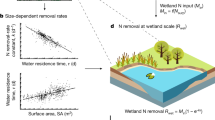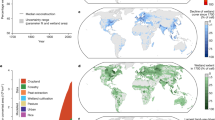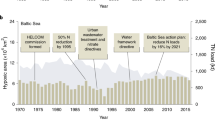Abstract
Intensively managed row crop agriculture has fundamentally changed Earth surface processes within the Mississippi River basin through large-scale alterations of land cover, hydrology and reactive nitrogen availability. These changes have created leaky landscapes where excess agriculturally derived nitrate degrades riverine water quality at local, regional and continental scales. Individually, wetlands are known to remove nitrate but the conditions under which multiple wetlands meaningfully reduce riverine nitrate concentration have not been established. Only one region of the Mississippi River basin—the 44,000 km2 Minnesota River basin—still contains enough wetland cover within its intensively agriculturally managed watersheds to empirically address this question. Here we combine high-resolution land cover data for the Minnesota River basin with spatially extensive repeat water sampling data. By clearly isolating the effect of wetlands from crop cover, we show that, under moderate–high streamflow, wetlands are five times more efficient per unit area at reducing riverine nitrate concentration than the most effective land-based nitrogen mitigation strategies, which include cover crops and land retirement. Our results suggest that wetland restorations that account for the effects of spatial position in stream networks could provide a much greater benefit to water quality then previously assumed.
This is a preview of subscription content, access via your institution
Access options
Access Nature and 54 other Nature Portfolio journals
Get Nature+, our best-value online-access subscription
$29.99 / 30 days
cancel any time
Subscribe to this journal
Receive 12 print issues and online access
$259.00 per year
only $21.58 per issue
Buy this article
- Purchase on Springer Link
- Instant access to full article PDF
Prices may be subject to local taxes which are calculated during checkout




Similar content being viewed by others
References
Mulholland, P. J. et al. Stream denitrification across biomes and its response to anthropogenic nitrate loading. Nature 452, 202–205 (2008).
Dahl, T. E. Wetlands Losses in the United States 1780’s to 1980’s (US Department of the Interior, Fish and Wildlife Service, Washington DC, 1990).
McIsaac, G. F., David, M. B., Gertner, G. Z. & Goolsby, D. A. Relating net nitrogen input in the Mississippi River Basin to nitrate flux in the Lower Mississippi River: A comparison of approaches. J. Environ. Qual. 31, 1610–1622 (2002).
Vitousek, P. M. et al. Human alteration of the global nitrogen cycle: sources and consequences. Ecol. Appl. 7, 737–750 (1997).
Rabalais, N. N., Turner, R. E. & Wiseman, W. J. Gulf of Mexico hypoxia, a.k.a. ‘The Dead Zone’. Annu. Rev. Ecol. Syst. 33, 235–263 (2002).
McLellan, E. et al. Reducing nitrogen export from the Corn Belt to the Gulf of Mexico: agricultural strategies for remediating hypoxia. J. Am. Water Resour. Assoc. 51, 263–289 (2015).
Gulf Hypoxia Action Plan 2008 (United States Environmental Protection Agency, 2008); https://www.epa.gov/ms-htf/gulf-hypoxia-action-plan-2008
Fisher, J. & Acreman, M. C. Wetland nutrient removal: A review of the evidence. Hydrol. Earth Syst. Sci. 8, 673–685 (2004).
Kadlec, R. H. Constructed marshes for nitrate removal. Crit. Rev. Environ. Sci. Technol. 42, 934–1005 (2012).
Strayer, D. L. et al. Effects of land cover on stream ecosystems: roles of empirical models and scaling issues. Ecosystems 6, 407–423 (2003).
Powers, S. M., Robertson, D. M. & Stanley, E. H. Effects of lakes and reservoirs on annual river nitrogen, phosphorus, and sediment export in agricultural and forested landscapes. Hydrol. Process. 28, 5919–5937 (2013).
Arheimer, B. & Wittgren, H. B. Modelling nitrogen removal in potential wetlands at the catchment scale. Ecol. Eng. 19, 63–80 (2002).
Kalkhoff, S. J., Hubbard, L. E., Tomer, M. D. & James, D. E. Effect of variable annual precipitation and nutrient input on nitrogen and phosphorus transport from two Midwestern agricultural watersheds. Sci. Tot. Environ. 559, 53–62 (2016).
Royer, T. V., David, M. B. & Gentry, L. E. Timing of riverine export of nitrate and phosphorus from agricultural watersheds in Illinois: Implications for reducing nutrient loading to the Mississippi River. Environ. Sci. Technol. 40, 4126–31 (2006).
Turner, R. E., Rabalais, N. N. & Justic, D. Gulf of Mexico hypoxia: alternate states and a legacy. Environ. Sci. Technol. 42, 2323–2327 (2008).
Donner, S. D. & Scavia, D. How climate controls the flux of nitrogen by the Mississippi River and the development of hypoxia in the Gulf of Mexico. Limnol. Oceanogr. 52, 856–861 (2007).
Van Meter, K. J., Basu, N. B., Veenstra, J. J. & Burras, C. L. The nitrogen legacy: emerging evidence of nitrogen accumulation in anthropogenic landscapes. Environ. Res. Lett. 11, 035014 (2016).
Seitzinger, S. et al. Denitrification across landscapes and waterscapes: a synthesis. Ecol. Appl. 16, 2064–2090 (2006).
Wagenhoff, A., Clapcott, J. E., Lau, K. E. M., Lewis, G. D. & Young, R. G. Identifying congruence in stream assemblage thresholds in response to nutrient and sediment gradients for limit setting. Ecol. Appl. 36, 178–194 (2017).
Qiu, J. & Turner, M. G. Importance of landscape heterogeneity in sustaining hydrologic ecosystem services in an agricultural watershed. Ecosphere 6, 229 (2015).
Hansen, A. T., Dolph, C. L. & Finlay, J. C. Do wetlands enhance downstream denitrification in agricultural landscapes? Ecosphere 7, e01516 (2016).
Zarnetske, J. P., Haggerty, R., Wondzell, S. M. & Baker, M. A. Labile dissolved organic carbon supply limits hyporheic denitrification. J. Geophys. Res. Biogeosci. 116, G04036 (2011).
Duan, S., He, Y., Kaushal, S. S. & Bianchi, T. S. Impact of wetland decline on decreasing dissolved organic carbon concentrations along the Mississippi River continuum. Front. Mar. Sci. 3, 280 (2017).
Taylor, P. G. & Townsend, A. R. Stoichiometric control of organic carbon–nitrate relationships from soils to the sea. Nature 464, 1178–1181 (2010).
Kessler, A. C. & Gupta, S. C. Drainage impacts on surficial water retention capacity of a prairie pothole watershed. J. Am. Water Resour. Assoc. 51, 1101–1113 (2015).
Pryor, S. C., Barthelmie, R. J. & Schoof, J. T. High-resolution projections of climate-related risks for the Midwestern USA. Clim. Res. 56, 61–79 (2013).
Watershed Modeling to Assess the Sensitivity of Streamflow, Nutrient, and Sediment Loads to Potential Climate Change and Urban Development in 20 U.S. Watersheds (National Center for Environmental Assessment, US EPA, 2013).
Cohen, M. J. et al. Do geographically isolated wetlands influence landscape functions? Proc. Natl Acad. Sci. USA 113, 1978–1986 (2016).
Marton, J. M. et al. Geographically isolated wetlands are important biogeochemical reactors on the landscape. BioScience 65, 408–418 (2015).
Crumpton, W. G. Using wetlands for water quality improvement in agricultural watersheds; the importance of a watershed scale approach. Water Sci. Technol. 44, 559–564 (2001).
Mitsch, W. J., Day, J. W., Zhang, L. & Lane, R. R. Nitrate-nitrogen retention in wetlands in the Mississippi River Basin. Ecol. Eng. 24, 267–278 (2005).
Homer, C. G. et al. Completion of the 2011 National land cover database for the conterminous United States — representing a decade of land cover change information. Photogramm. Eng. Remote Sens. 81, 345–354 (2015).
Robertson, D. M. & Saad, D. A. SPARROW models used to understand nutrient sources in the Mississippi/Atchafalaya River Basin. J. Environ. Qual. 42, 1422–1440 (2013).
Blaen, P. J. et al. High-frequency monitoring of catchment nutrient exports reveals highly variable storm event responses and dynamic source zone activation. J. Geophys. Res. Biogeosci. 122, 2265–2281 (2017).
National Water Information System: USGS Water Data for Minnesota (United States Geological Survey, accessed 15 December 2016); http://waterdata.usgs.gov/mn/nwis.
Cowardin, L. M., Carter, V., Golet, F. C. & Laroe, E. T. Classification of wetlands and deepwater habitats of the United States. Wildl. Res. 79, 1979 (2004).
Dolph, C. L., Hansen, A. T. & Finlay, J. C. Flow-related dynamics in suspended algal biomass and its contribution to suspended particulate matter in an agricultural river network of the Minnesota River Basin, USA. Hydrobiologia 785, 127–147 (2016).
Foufoula-Georgiou, E., Takbiri, Z., Czuba, J. A. & Schwenk, J. The change of nature and the nature of change in agricultural landscapes: Hydrologic regime shifts modulate ecological transitions. Wat. Resour. Res. 51, 6649–6671 (2015).
National Wetland Inventory Update for Minnesota (Minnesota Department of Natural Resources, 2015); https://gisdata.mn.gov/dataset/water-nat-wetlands-inv-2009-2014.
Knight, J. Land Cover & Impervious: Minnesota 2013 v.2 (University of Minnesota, accessed 6 April 2016); https://rsl.gis.umn.edu.
Cropland Data Layer: Published Crop-specific Data Layer (United States Department of Agriculture: National Agricultral Statistics Service, Washington DC, accessed 15 May 2017); https://nassgeodata.gmu.edu/CropScape.
Tabachnick, B. G. & Fidell, L. S. Using Multivariate Statistics (Harper Collins, New York, 1996).
Water Quality Data (MPCA, accessed 31 August 2016); https://www.pca.state.mn.us/water/water-quality-data.
Acknowledgements
This research was funded by the National Science Foundation (NSF) through a NSF Science, Engineering and Education for Sustainability (SEES) Fellows grant (EAR-1415206) to A.T.H. and through a Water Sustainability and Climate Program (WSC) Observatory grant (EAR-1209402): REACH (Resilience under Accelerated Change). C.L.D. was additionally funded by an environmental grant from the Mortenson Family Foundation. We thank the many members of the Finlay Lab who assisted with sample collection and processing, especially A. Keeler, E. Senyk, K. Kemmit and M. Rorer.
Author information
Authors and Affiliations
Contributions
A.T.H. and J.C.F. conceived of the project. A.T.H. and C.L.D. conducted field work and analysed laboratory data. E.F.-G., J.C.F. and A.T.H. interpreted results. A.T.H. wrote the original paper while C.L.D., J.C.F. and E.F.-G. contributed significantly to the final version.
Corresponding author
Ethics declarations
Competing interests
The authors declare no competing financial interests.
Additional information
Publisher’s note: Springer Nature remains neutral with regard to jurisdictional claims in published maps and institutional affiliations.
Supplementary information
Supplementary Information
Supplementary figures and tables
Rights and permissions
About this article
Cite this article
Hansen, A.T., Dolph, C.L., Foufoula-Georgiou, E. et al. Contribution of wetlands to nitrate removal at the watershed scale. Nature Geosci 11, 127–132 (2018). https://doi.org/10.1038/s41561-017-0056-6
Received:
Accepted:
Published:
Issue Date:
DOI: https://doi.org/10.1038/s41561-017-0056-6
This article is cited by
-
Consistent stoichiometric long-term relationships between nutrients and chlorophyll-a across shallow lakes
Nature Communications (2024)
-
Long-term wetland biomonitoring highlights the differential impact of land use on macroinvertebrate diversity in Dongting Lake in China
Communications Earth & Environment (2024)
-
Assessing the Impacts of Wetlands on Discharge and Nutrient Loading: Insights from Restoring Past Wetlands with GIS-Based Analysis and Modeling
Wetlands (2023)
-
Achieving balance between socioeconomic development and ecosystem conservation via policy adjustments in Guangdong Province of southeastern China
Environmental Science and Pollution Research (2023)
-
Reimagining large river management using the Resist–Accept–Direct (RAD) framework in the Upper Mississippi River
Ecological Processes (2023)



